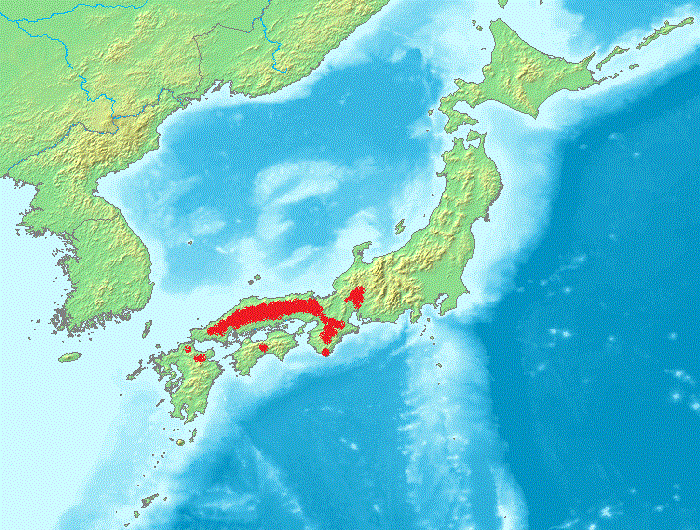|
Liolope
''Liolope'' is a monotypic genus of trematodes, or fluke worms, belonging to the family Liolopidae. The only species is ''Liolope copulans''. Baba et al. (2011) classified this species in the family Liolopidae, superfamily Diplostomoidea. Distribution This species occurs in Japan. Life cycle The first intermediate hosts of ''Liolope copulans'' include freshwater snails '' Semisulcospira libertina''.Baba T., Hosoi M., Urabe M., Shimazu T., Tochimoto T. & Hasegawa H. (2011). "''Liolope copulans'' (Trematoda: Digenea: Liolopidae) parasitic in ''Andrias japonicus'' (Amphibia: Caudata: Cryptobranchidae) in Japan: Life cycle and systematic position inferred from morphological and molecular evidence". ''Parasitology International'' 60(2): 181–192. . . The second (experimental) intermediate host include fish ''Nipponocypris sieboldii'' and ''Rhynchocypris lagowskii The Amur minnow or Lagowski's minnow (''Rhynchocypris lagowskii'') is an Asian species of small freshwater cypr ... [...More Info...] [...Related Items...] OR: [Wikipedia] [Google] [Baidu] |
Semisulcospira Libertina
''Semisulcospira libertina'' is a species of freshwater snail with an operculum, an aquatic gastropod mollusk in the family Semisulcospiridae. Widespread in east Asia, it lives in China, Taiwan, Korea, Japan, and the Philippines. In some countries it is harvested as a food source. It is medically important as a vector of clonorchiasis, paragonimiasis, metagonimiasis and others. Taxonomy The type specimens were collected by American scientist William Stimpson during the North Pacific Exploring and Surveying Expedition (1853–1856). This species was originally described under the name ''Melania libertina'' by American malacologist Augustus Addison Gould in 1859. The specific name ''libertina'' is from Latin language and means a "freedwoman". ''Semisulcospira libertina'' is the type species of the genus ''Semisulcospira'' by subsequent designation The International Code of Zoological Nomenclature (ICZN) is a widely accepted convention in zoology that rules the formal scient ... [...More Info...] [...Related Items...] OR: [Wikipedia] [Google] [Baidu] |
Liolopidae
Liolopidae is a family of trematodes belonging to the order Diplostomida. Genera: * '' Dracovermis'' Brooks & Overstreet, 1978 * '' Harmotrema'' Nicoll, 1914 * '' Liolope'' Cohn, 1902 References {{Taxonbar, from=Q20736080 Platyhelminthes ... [...More Info...] [...Related Items...] OR: [Wikipedia] [Google] [Baidu] |
Ludwig Cohn
Ludwig Cohn (1873 – 1935) was a German naturalist. Beginning in 1904 he worked as a zoological assistant at the '' Städtischen Museum für Natur-, Völker- und Handelskunde'' (Municipal Museum of natural history, ethnology and trade history) in Bremen, under the direction of Hugo Schauinsland (1857–1937). In 1920 he was promoted to head of the natural history department at the museum. He is known for two scientific trips to what is now part of Papua New Guinea, being sponsored by the Bremen museum. His first journey (1908/09) was to the Solomon Islands. With explorer Karl Nauer (1874–1962), he performed scientific research on Buka and Bougainville, collecting an array of natural and ethnographic objects. As a result of the expedition, a ''Junggesellenhaus'' (bachelor dwelling) from the island of Tijob, and a ''Familienwohnhaus'' (family house) from the settlement of Toboroi, became centerpieces at the opening of the South Seas Exhibition (1911) at the Bremen museum. ... [...More Info...] [...Related Items...] OR: [Wikipedia] [Google] [Baidu] |
Monotypic Genus
In biology, a monotypic taxon is a taxonomic group (taxon) that contains only one immediately subordinate taxon. A monotypic species is one that does not include subspecies or smaller, infraspecific taxa. In the case of genera, the term "unispecific" or "monospecific" is sometimes preferred. In botanical nomenclature, a monotypic genus is a genus in the special case where a genus and a single species are simultaneously described. In contrast, an oligotypic taxon contains more than one but only a very few subordinate taxa. Examples Just as the term ''monotypic'' is used to describe a taxon including only one subdivision, the contained taxon can also be referred to as monotypic within the higher-level taxon, e.g. a genus monotypic within a family. Some examples of monotypic groups are: Plants * In the order Amborellales, there is only one family, Amborellaceae and there is only one genus, '' Amborella'', and in this genus there is only one species, namely ''Amborella trichopoda.' ... [...More Info...] [...Related Items...] OR: [Wikipedia] [Google] [Baidu] |
Trematodes
Trematoda is a class of flatworms known as flukes. They are obligate internal parasites with a complex life cycle requiring at least two hosts. The intermediate host, in which asexual reproduction occurs, is usually a snail. The definitive host, where the flukes sexually reproduce, is a vertebrate. Infection by trematodes can cause disease in all five traditional vertebrate classes: mammals, birds, amphibians, reptiles, and fish. Etymology Trematodes are commonly referred to as flukes. This term can be traced back to the Old English name for flounder, and refers to the flattened, rhomboidal shape of the organisms. Taxonomy There are 18,000 to 24,000 known species of trematodes, divided into two subclasses — the Aspidogastrea and the Digenea. Aspidogastrea is the smaller subclass, comprising 61 species. These flukes mainly infect bivalves and bony fishes.https://www.biotaxa.org/Zootaxa/article/view/zootaxa.3918.3.2 Digenea — which comprise the majority of trematodes — ... [...More Info...] [...Related Items...] OR: [Wikipedia] [Google] [Baidu] |
Japan
Japan ( ja, 日本, or , and formally , ''Nihonkoku'') is an island country in East Asia. It is situated in the northwest Pacific Ocean, and is bordered on the west by the Sea of Japan, while extending from the Sea of Okhotsk in the north toward the East China Sea, Philippine Sea, and Taiwan in the south. Japan is a part of the Ring of Fire, and spans Japanese archipelago, an archipelago of List of islands of Japan, 6852 islands covering ; the five main islands are Hokkaido, Honshu (the "mainland"), Shikoku, Kyushu, and Okinawa Island, Okinawa. Tokyo is the Capital of Japan, nation's capital and largest city, followed by Yokohama, Osaka, Nagoya, Sapporo, Fukuoka, Kobe, and Kyoto. Japan is the List of countries and dependencies by population, eleventh most populous country in the world, as well as one of the List of countries and dependencies by population density, most densely populated and Urbanization by country, urbanized. About three-fourths of Geography of Japan, the c ... [...More Info...] [...Related Items...] OR: [Wikipedia] [Google] [Baidu] |
Naturalis Biodiversity Center - Andrias Japonicus - Japanese Giant Salamander - Siebold Collection
Naturalis Biodiversity Center ( nl, Nederlands Centrum voor Biodiversiteit Naturalis) is a national museum of natural history and a research center on biodiversity in Leiden, Netherlands. It was named the European Museum of the Year 2021. Although its current name and organization are relatively recent, the history of Naturalis can be traced back to the early 1800s. Its collection includes approximately 42 million specimens, making it one of the largest natural history collections in the world. History The beginnings of Naturalis go back to the creation of the Rijksmuseum van Natuurlijke Historie (abbreviated RMNH, National Museum of Natural History) by Dutch King William I on August 9, 1820. In 1878, the geological and mineralogical collections of the museum were split off into a separate museum, remaining distinct until the merger of the Rijksmuseum van Natuurlijke Historie with the Rijksmuseum van Geologie en Mineralogie (abbreviated RGM) in 1984, to form the Nationa ... [...More Info...] [...Related Items...] OR: [Wikipedia] [Google] [Baidu] |
Parasitology International
Parasitology is the study of parasites, their hosts, and the relationship between them. As a biological discipline, the scope of parasitology is not determined by the organism or environment in question but by their way of life. This means it forms a synthesis of other disciplines, and draws on techniques from fields such as cell biology, bioinformatics, biochemistry, molecular biology, immunology, genetics, evolution and ecology. Fields The study of these diverse organisms means that the subject is often broken up into simpler, more focused units, which use common techniques, even if they are not studying the same organisms or diseases. Much research in parasitology falls somewhere between two or more of these definitions. In general, the study of prokaryotes falls under the field of bacteriology rather than parasitology. Medical The parasitologist F.E.G. Cox noted that "Humans are hosts to nearly 300 species of parasitic worms and over 70 species of protozoa, some derived ... [...More Info...] [...Related Items...] OR: [Wikipedia] [Google] [Baidu] |
Nipponocypris Sieboldii
''Nipponocypris sieboldii'' is a species of cyprinid in the genus '' Nipponocypris'' that is endemic to Japan Japan ( ja, 日本, or , and formally , ''Nihonkoku'') is an island country in East Asia. It is situated in the northwest Pacific Ocean, and is bordered on the west by the Sea of Japan, while extending from the Sea of Okhotsk in the north .... It has a maximum length of . References Cyprinidae Cyprinid fish of Asia Fish of Japan Taxa named by Coenraad Jacob Temminck Taxa named by Hermann Schlegel Fish described in 1846 {{Cyprinidae-stub ... [...More Info...] [...Related Items...] OR: [Wikipedia] [Google] [Baidu] |
Rhynchocypris Lagowskii
The Amur minnow or Lagowski's minnow (''Rhynchocypris lagowskii'') is an Asian species of small freshwater cyprinid fish. It is found from the Lena and Amur rivers in the north to the Yangtze The Yangtze or Yangzi ( or ; ) is the longest river in Asia, the third-longest in the world, and the longest in the world to flow entirely within one country. It rises at Jari Hill in the Tanggula Mountains (Tibetan Plateau) and flows ... in China in the south, and in Japan. References Rhynchocypris Freshwater fish of China Fish of Russia Fauna of Siberia Fish described in 1869 {{Leuciscinae-stub ... [...More Info...] [...Related Items...] OR: [Wikipedia] [Google] [Baidu] |
Japanese Giant Salamander
The Japanese giant salamander (''Andrias japonicus'') is a species of fully aquatic giant salamander endemic to Japan. With a length of up to ,''Andrias japonicus'' - Amphibiaweb it is the third-largest in the world, only being surpassed by the very similar and closely related (''A. davidianus''). It is known in Japanese as , literally meaning "giant salamander". Other local names include ''Hanzaki'''','' ''Hanzake','' and ''Anko ... [...More Info...] [...Related Items...] OR: [Wikipedia] [Google] [Baidu] |





